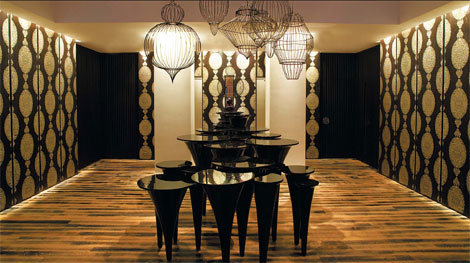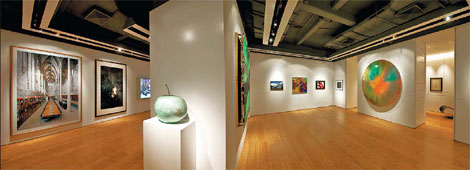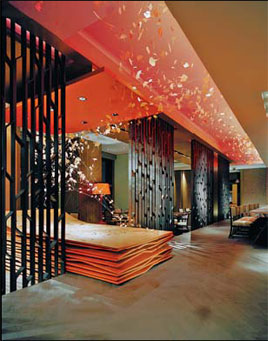Andre Fu, boy wonder
Updated: 2011-07-18 11:09
By Rebecca Lo (China Daily)
|
|||||||||
 |
|
Jia Shanghai The 1920s building on the corner of Shanghai's Nanjing and Tai Xing roads provided the setting for an exploration of China's eclecticism, as Fu used ornate French brocade and washed oak hardwood flooring to foster comfort while still maintaining an edge. Jia Shanghai |

 |
|
Jia Shanghai The 1920s building on the corner of Shanghai's Nanjing and Tai Xing roads provided the setting for an exploration of China's eclecticism, as Fu used ornate French brocade and washed oak hardwood flooring to foster comfort while still maintaining an edge. Jia Shanghai |
His looks belie his experience as a world-class designer. Rebecca Lo catches up with the Hong Kong architect, to talk about his latest project - with Tai Ping carpets - and his first book, A Bespoke Journey.
I first met Andre Fu nine years ago when he was still based in London. He was already hailed as a talent to watch by Wallpaper after bursting upon the Asian design scene with Zen in Shanghai's Xintiandi. At the time, he was a fresh young face who had formed a company with Stephane Orsolini after they met while working for John Pawson in London. He related a story about how his inspiration for a series of backlit bronze glass screens came from his grandmother being fitted for dresses in front of a wrap-around mirror. Many years later, in his first hotel and Swire Properties' flagship property The Upper House, echoes of those screens can be seen behind the reception at its signature restaurant, Cafe Gray Deluxe.
Life has a way of coming full circle. And though in some ways Fu is still the same quiet, unassuming, somewhat untouchable architect, his projects have become more sophisticated and rigorous while at the same time more fun and easier to experience.
|
|
|
Nadaman Japanese Restaurant Inside Shangri-La Tokyo, Nadaman was inspired by nature and incorporates a number of sculptural elements to evoke a calm beauty that is both Japanese and yet bears Fu's unique oeuvre. Nadaman Japanese Restaurant |
The deliberate layering of different levels for contemplation is something that Fu has refined over the years. It is also something that translates well into photos that make up A Bespoke Journey, a book published by The Antithesis that looks back at 10 years, and 12 of his most important projects.
Hong Kong's most celebrated boy architect first dabbled in hotel design with Opia restaurant at Philippe Starck's Jia in Causeway Bay. It was also his first hospitality project in Hong Kong following high-profile jobs such as film star Michelle Yeoh's residence on The Peak.
He followed up with Nadaman Japanese restaurant in Shangri-La Tokyo, Cassia Chinese restaurant in Singapore's Capella resort, La Loggia for agns b in Hong Kong's IFC Mall and The Upper House. All of these are illustrated in A Bespoke Journey alongside some of his conceptual hand sketches.
"When I design, I still sketch," Fu confesses. "I'm not into gadgets and I'm not very supportive of computer renderings. Hand-sketching is much more personal. I'm more into crafts."
His appreciation for fine craftsmanship may be the driver behind his collaboration with Hong Kong's Tai Ping Carpets, launched earlier this year.
"It is an urban cityscape," he says. "It's the grid of a faade applied to the techniques that Tai Ping has developed over the years. The story began with my visit to its factory. I went through the entire process from weaving to tufting.
"I was the first Chinese designer to collaborate with Tai Ping despite the fact that they have roots in Hong Kong. It was a bit of a homecoming exercise - to be invited to come up with a collection that embodies Asian sensibilities with a strong international flavor. It is a very international company, similar to my approach and how I have built up my office."
Fu keeps his boutique firm limited to 15 people and works on a very select number of projects in relation to how many requests his office fields. These include a new concept shop for Lane Crawford on Canton Road, a 52-story Hong Kong residential tower slated for completion in 2014 and major works in Shanghai, Suzhou and Hangzhou as well as a sky bar in the soon to be open Shangri-La London.
He is in the enviable position of being able to turn down work that doesn't interest him, choosing instead to take a personal interest in every commission.
"I'm in the luxury business," he admits. "In terms of design, I'm always creating places that are intended to go hand in hand with the luxury world. But real luxury for me these days is to have time."
Despite his assertions that he is not designing 24/7 and goes on holidays to Bali for sun and sand just like a regular guy, Fu's hobbies speak for themselves.
"It's hard to quantify when I'm working and when I'm not working," he shrugs. "In the summer, on a Sunday that I'm in town, I'll go swimming in the afternoon and then have dinner with my parents.
"I have a small art collection. I enjoy art that is a cross between sculpture and furniture. I recently bought a piece by Jean-Michel Othoniel from Galerie Perrotin. Most people know his work through his Pearl necklace for Chanel in Prince's Building. I bought a screen that he did with Murano glass balls. I like that a piece of furniture can escalate to take on an artistic quality."
Followers of Fu's work can say the same about his portfolio of projects, as he continues to explore the cultural elements that influence his evolving style. "Ultimately, I'm creating places for people and I'm responding to the location, the client and the vision that they have," he says. "But equally and because our environment is evolving, I probably evolve with it."
